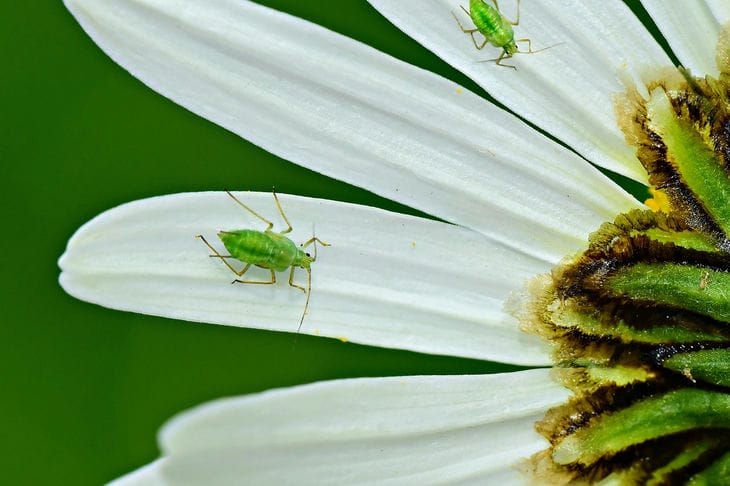Among the many types of garden insect pests, aphids are the most common.
Currants, potatoes, cabbage, tomatoes, cucumbers, ornamental plants – they are all susceptible to this scourge.
Aphids not only suck the juice out of plants, but also carry various diseases of garden crops, says Anastasia Kovrizhnykh .

The pest is extremely prolific and quickly spreads across the entire area of the site. What to do and how to fight these insects? We will tell you about the most effective methods of destroying aphids in this article.
What is aphid and why is it dangerous?
Aphids are small, weak, but extremely prolific and voracious insects. There are many species of aphids that attack different crops. Representatives of different species differ from each other in color, and may have wings or be wingless.
Nymphs and adults extract food materials from the plant, which disrupts the balance of growth hormones, and subsequently leads to deformation of leaves or even death of young plants. The insect cannot damage the fruits, because their shell is too hard for its jaws.
In asexual reproduction, young insects are born as developed nymphs; they immediately begin to feed on leaf juices and grow rapidly; they molt 4 times before reaching maturity.
With each molt, aphids leave a white "skin" on surfaces, which gives away their presence. During the feeding process, these pests secrete "honeydew" on the surface of plants, which is a comfortable environment for the development of fungi.
Their saliva can also cause a strong allergic reaction in various garden crops and create stress.
Aphids are one of the most active carriers of viruses, which is why many gardeners are afraid of them.
Using a soap solution with added oil and herbs
Professional agronomists usually recommend chemicals. However, it is reasonable to use such heavy means of control only when the time for trying to localize the aphid infestation in a relatively small area of the garden or orchard has already been lost.
To avoid the problem becoming a problem, preventive measures are necessary: inspect crops more often and more carefully in order to detect pests in a timely manner; attract beneficial insects to the area, such as lacewings and ladybugs; try to control the number of ants - oddly enough, they are considered to be aphid distributors.
At the early stages of the pest's appearance and spread, the best of the safest means for humans, plants and the environment is laundry soap. One 100-gram piece is per liter of water; as soon as the soap is completely dissolved, the concentrate is ready for use.
It is best if you always have 2-3 such containers ready: even if only one individual is found, you should safely consider the entire area infested and begin the first treatments as quickly as possible.
To obtain a ready-made solution, 9 liters of water and 200 grams of any vegetable oil are added to 1 liter of soap concentrate.
To enhance the insecticidal properties, the concentrate is prepared in a different way - on the basis of herbs that repel pests or are poisonous to them, or, conversely, attract beneficial insects to the area.
These can be thyme, wormwood, needles of any coniferous plants, tobacco dust, celandine, any ground pepper. One large such raw material per 1 liter of boiling water is enough to prepare the base for the concentrate. The product is infused for 40-60 minutes in a tightly closed container, placed in a warm, dark place. Soap is added here last.
Note that in this case it will not be possible to prepare the concentrate in advance - before each treatment you will have to prepare a fresh composition, to which the same amount of water is added - 9 liters.
Aphids are quite small insects; even if they barely come into contact with such a liquid, they will immediately stick and will not be able to move further; the oil in the mixture will block the access of oxygen, and the toxic substances of the plants listed above will immediately poison them.
To contain the first waves of aphids, it is necessary to spray this composition on the plants and soil throughout the entire area from the beginning to the middle of summer, every 10-12 days.
The product is also suitable for preventing the spread of spider mites, cicadas, thrips, powdery mildew, and any small pests or fungal diseases.
Use of bitoxibacillin and actocide at any degree of damage
Both preparations are absolutely safe for humans and the environment: bitoxibacillin contains only bacteria that are pathogenic for many small pest species; actocid is a waste product of Streptomyces avermectilis microorganisms. Both preparations have a wide range of applications.
In the absence of actocide, actofit can be used; it has the same active substances, only in a lower concentration, so its dosage in the mixture should be increased by 2-2.5 times.
For 15 liters of water, take 45 ml of actocide (or 90 ml of actofit) and 300 ml of bitoxybacillin; mix everything thoroughly and immediately begin spraying the plants and soil throughout the entire area with infected crops.
The mixture works best at an ambient temperature of at least 18 degrees Celsius. If the temperature is above 25 degrees, the dosage of actocide can be safely reduced by a third without losing its effectiveness.
The frequency of treatment is once every 10 days; contact of biological agents with chemical preparations is extremely undesirable and will inevitably reduce the effectiveness of the former, so all containers must be thoroughly washed from chemical residues before use to prepare this mixture.
The active ingredients of both preparations do not penetrate into the tissues of the fruit, so after a day or two the products can be safely washed and eaten.
This mixture is rightfully recognized as the most effective: aphids die after 1-2 treatments and literally fall off the plants; it helps even in cases where traditional “heavy” chemicals do not have the desired effect on pests.
Previously we talked about repelling ticks using aromas.









